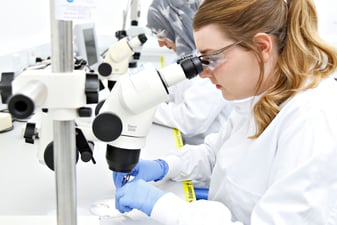High blood pressure, or hypertension, remains one of the most prevalent risk factors for cardiovascular disease worldwide, contributing to millions of deaths each year.1 While many therapies target blood pressure, for most new drugs, it is vital to avoid adverse effects by raising or lowering blood pressure. Predicting how a new compound will affect vascular tone – whether it will cause a vessel to constrict or relax – remains a key challenge in drug development. This is where subcutaneous artery assays can make a significant impact.
Subcutaneous resistance arteries play a central role in peripheral vascular resistance, a major determinant of systemic blood pressure.2 By studying these small arteries ex vivo, researchers can directly measure contractile and relaxation responses to drug candidates under tightly controlled conditions. These assays provide valuable insights into the mechanisms of vasodilation and vasoconstriction, helping to identify compounds that might normalize or dysregulate blood pressure in humans.
Unlike animal models, which often fail to fully replicate human vascular responses, subcutaneous artery assays using human donor tissue offer a more clinically relevant platform for assessing vascular pharmacology.3 As such, they are increasingly used to investigate the efficacy and safety of antihypertensive drugs, vasodilators and compounds with potential off-target vascular effects.
The Role of Vascular Tone in Blood Pressure Regulation
Blood pressure is determined by two key factors: cardiac output (the volume of blood the heart pumps per minute) and peripheral resistance (the resistance blood encounters as it flows through vessels). One of the most influential contributors to peripheral resistance is vascular tone – the degree of constriction or dilation in small arteries and arterioles, especially those found in subcutaneous tissue, the gastrointestinal system and skeletal muscle. The dynamic regulation allows the cardiovascular system to respond to changes in oxygen demand, temperature, and neural or hormonal signals.4
Subcutaneous resistance arteries are especially important in this process because they are part of the microvascular network that governs systemic vascular resistance, which in turn has a direct influence on mean arterial pressure (MAP).5
Several classes of drugs target these mechanisms to treat hypertension and cardiovascular disorders.
- ACE inhibitors: Block the conversion of angiotensin I to angiotensin II, a potent vasoconstrictor, leading to vessel relaxation and reduced blood pressure.6
- Calcium channel blockers: Inhibit calcium entry into vascular smooth muscle cells, preventing contraction and promoting vasodilation.7
- Direct vasodilators such as nitroglycerin: Act directly on the smooth muscle of the vessel wall to reduce tone and widen the arteries.
- Phosphodiesterase inhibitors: Cause vasodilation by inhibiting enzymes (phosphodiesterases, or ‘PDEs’) that normally breakdown signalling molecules within smooth muscle cells (cAMP and cGMP)
Understanding how these drugs modulate vascular tone at the tissue level helps researchers predict therapeutic efficacy and identify potential safety concerns early in development.

Pictured: dissected subcutaneous resistance arteries.
Why Use Subcutaneous Arteries in Research?
Subcutaneous resistance arteries play a critical role in regulating peripheral vascular resistance, which is a major determinant of overall blood pressure. These tiny blood vessels, typically 100-400 micrometres in diameter, are actively involved in controlling blood flow to the skin and extremities, making them highly responsive to vasoconstrictive and vasodilatory stimuli.8 Conducting ex vivo studies using these arteries allows researchers to directly observe how blood vessels respond to pharmacological agents in a highly controlled environment, while preserving their native structure and function.
Using human subcutaneous arteries offers several advantages. Ex vivo testing of human tissues provides results that more closely mirror actual patient responses than animal models or cell-based systems. This is particularly important when studying blood pressure regulation, when vascular tone and endothelial function vary significantly between species.9 Tissue can be obtained from a broad range of donors, encompassing both healthy and diseased vessels. This offers valuable insight into how vascular dysfunction alters responses to drug candidates.10 These tissues are gathered in ethical and sustainable ways, sourced as surplus tissue from elective surgical procedures such as skin reductions or reconstructions.11 This approach supports ethical research while making full use of the available biological material that would otherwise be discarded.
Subcutaneous artery assays are especially powerful for evaluating vasodilation and vasoconstriction responses ex vivo, helping researchers better understand drug mechanisms, safety profiles and potential off-target cardiovascular effects in a human-relevant model.
How Subcutaneous Artery Assays Work
Ex vivo studies preserve the structural and functional integrity of the artery, allowing for precise measurement of vasoconstriction and vasodilation in response to pharmacological agents. During the tissue preparation and mounting phase of the assay, the arteries are cleaned of surrounding fat and connective tissue and then mounted onto a wire or pressure myograph system. These systems are designed to maintain physiological conditions such as temperature, pH, and oxygenation to preserve vessel viability.12
Once mounted, the artery is exposed to cumulative concentrations of test compounds. Using the myograph, researchers can measure changes in vascular tension or internal diameter in real time. This allows for quantitative analysis of vasodilator or vasoconstrictor effects, as well as calculation of pharmacological parameters such as EC₅₀ and maximum response.13
Vasoconstriction assays can reveal how a test compound increases vascular tone, which may indicate hypertensive potential. Vasodilation assays, often performed after pre-constricting the artery with a standard agent, assess the ability of the drug to relax the vessel. Additional studies may evaluate endothelium-dependent versus endothelium-independent mechanisms by mechanically removing the endothelium or using inhibitors such as L-NAME to block nitric oxide pathways.14
This ex vivo approach provides a unique opportunity to study human vascular pharmacology in a controlled environment that closely mirrors in vivo physiology, without the variability introduced by whole-animal models or the oversimplification of cell-based assays.
Applications in Drug Discovery and Safety Pharmacology
Ex vivo assays using human subcutaneous arteries are increasingly recognized as a valuable tool in both early and late-stage cardiovascular drug development. By providing direct insight into how compounds affect vascular tone in human tissue, these assays help bridge the translational gap between preclinical findings and clinical outcomes. These assays are ideal for assessing how new or existing compounds affect vascular tone, especially in the context of hypertension, heart failure or endothelial dysfunction. Because the responses are measured in human tissue, the data are highly predictive of clinical outcomes.15
For non-cardiovascular drugs, ex vivo artery studies help detect off-target effects such as vasoconstriction that could lead to elevated blood pressure. This makes them valuable for meeting regulatory expectations for cardiovascular safety profiling.16
Researchers can use these assays to study specific pathways, such as endothelium-dependent relaxation, NO signalling, or renin-angiotensin modulation, to refine the drug’s mechanism of action and guide dosing decisions. Access to arteries from donors of different ages, disease states, and ethnic backgrounds enables early evaluation of population-specific responses, supporting more personalised and inclusive drug development strategies.17
Conclusion
Subcutaneous artery assays provide a human-relevant, ex vivo platform for exploring how drugs influence vascular tone and blood pressure. By preserving the functional integrity of small resistance arteries, these assays enable detailed pharmacological and safety assessments that are more predictive than traditional preclinical models. Whether evaluating antihypertensive efficacy or identifying cardiovascular liabilities, this approach delivers data that support confident decision-making in drug development. As the industry continues to prioritise translational relevance and ethical sourcing, subcutaneous artery studies are becoming an essential component of modern vascular research.
Check out our assays on subcutaneous resistance arteries in our assay catalogue here.
References
1. “Hypertension.” World Health Organization, World Health Organization, www.who.int/news-room/fact-sheets/detail/hypertension. Accessed 26 June 2025.
2. Mulvany MJ, Aalkjaer C. Structure and function of small arteries. Physiol Rev. 1990 Oct;70(4):921-61. doi: 10.1152/physrev.1990.70.4.921. PMID: 2217559.
3. Garland, C.J., Hiley, C.R. and Dora, K.A. (2011), EDHF: spreading the influence of the endothelium. British Journal of Pharmacology, 164: 839-852. https://doi.org/10.1111/j.1476-5381.2010.01148.x
4. Khonsary S. A. (2017). Guyton and Hall: Textbook of Medical Physiology. Surgical Neurology International, 8, 275. https://doi.org/10.4103/sni.sni_327_17
5. Mulvany MJ, Aalkjaer C. Structure and function of small arteries. Physiol Rev. 1990 Oct;70(4):921-61. doi: 10.1152/physrev.1990.70.4.921. PMID: 2217559.
6. Ferrario CM, Strawn WB. Role of the renin-angiotensin-aldosterone system and proinflammatory mediators in cardiovascular disease. Am J Cardiol. 2006 Jul 1;98(1):121-8. doi: 10.1016/j.amjcard.2006.01.059. Epub 2006 May 9. PMID: 16784934.
7. Godfraind T. Discovery and Development of Calcium Channel Blockers. Front Pharmacol. 2017 May 29;8:286. doi: 10.3389/fphar.2017.00286. PMID: 28611661; PMCID: PMC5447095.
8. Mulvany MJ, Aalkjaer C. Structure and function of small arteries. Physiol Rev. 1990 Oct;70(4):921-61. doi: 10.1152/physrev.1990.70.4.921. PMID: 2217559.
9. Landesberg G, Gilon D, Meroz Y, Georgieva M, Levin PD, Goodman S, Avidan A, Beeri R, Weissman C, Jaffe AS, Sprung CL. Diastolic dysfunction and mortality in severe sepsis and septic shock. Eur Heart J. 2012 Apr;33(7):895-903. doi: 10.1093/eurheartj/ehr351. Epub 2011 Sep 11. PMID: 21911341; PMCID: PMC3345552.
10. Rizzoni D, Agabiti Rosei E. Small artery remodeling in hypertension and diabetes. Curr Hypertens Rep. 2006 Apr;8(1):90-5. doi: 10.1007/s11906-006-0046-3. PMID: 16600165.
11. Garland, C.J., Hiley, C.R. and Dora, K.A. (2011), EDHF: spreading the influence of the endothelium. British Journal of Pharmacology, 164: 839-852. https://doi.org/10.1111/j.1476-5381.2010.01148.x
12. Mulvany MJ, Halpern W. Contractile properties of small arterial resistance vessels in spontaneously hypertensive and normotensive rats. Circ Res. 1977 Jul;41(1):19-26. doi: 10.1161/01.res.41.1.19. PMID: 862138.
13. Buus N, Gonge H. Empirical studies of clinical supervision in psychiatric nursing: A systematic literature review and methodological critique. Int J Ment Health Nurs. 2009 Aug;18(4):250-64. doi: 10.1111/j.1447-0349.2009.00612.x. PMID: 19594645.
14. Félétou M, Vanhoutte PM. Endothelial dysfunction: a multifaceted disorder (The Wiggers Award Lecture). Am J Physiol Heart Circ Physiol. 2006 Sep;291(3):H985-1002. doi: 10.1152/ajpheart.00292.2006. Epub 2006 Apr 21. PMID: 16632549.
15. Ich S7A Safety Pharmacology Studies for Human Pharmaceuticals - Scientific Guideline.” European Medicines Agency (EMA), 1 June 2001, www.ema.europa.eu/en/ich-s7a-safety-pharmacology-studies-human-pharmaceuticals-scientific-guideline.
16. Rizzoni D, Porteri E, Boari GE, De Ciuceis C, Sleiman I, Muiesan ML, Castellano M, Miclini M, Agabiti-Rosei E. Prognostic significance of small-artery structure in hypertension. Circulation. 2003 Nov 4;108(18):2230-5. doi: 10.1161/01.CIR.0000095031.51492.C5. Epub 2003 Oct 13. PMID: 14557363.
17. Behrendt D, Ganz P. Endothelial function. From vascular biology to clinical applications. Am J Cardiol. 2002 Nov 21;90(10C):40L-48L. doi: 10.1016/s0002-9149(02)02963-6. PMID: 12459427.






